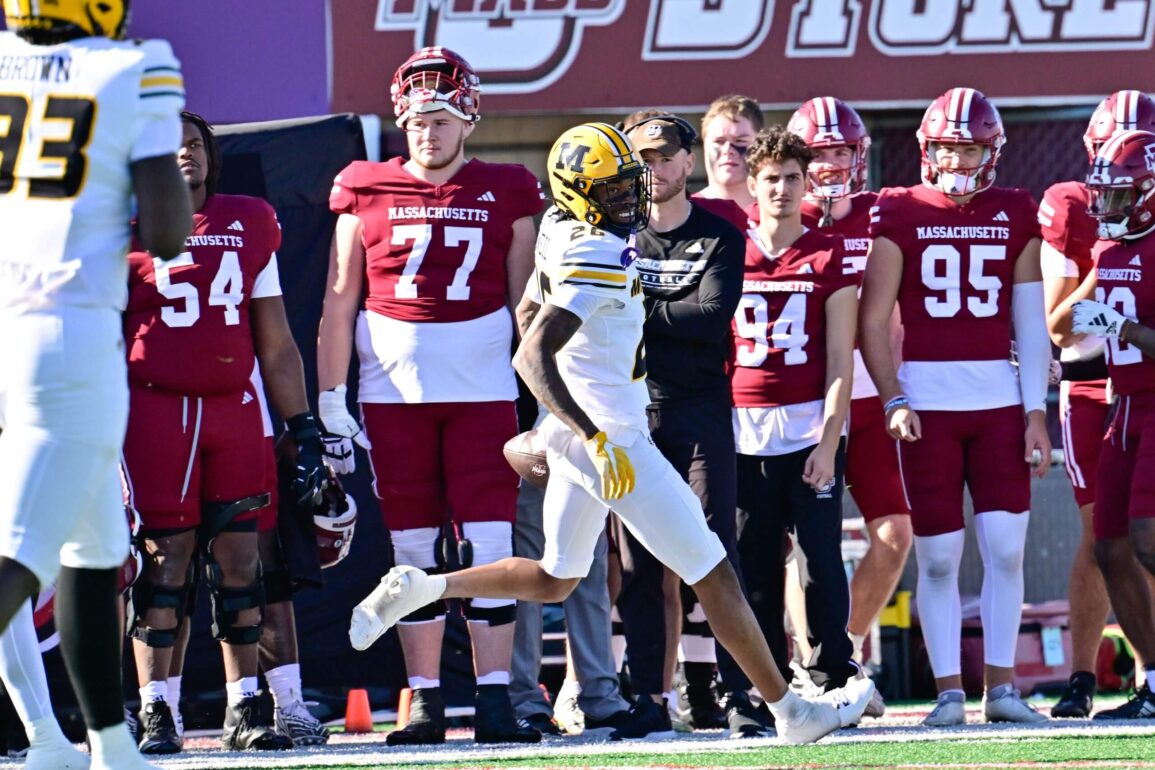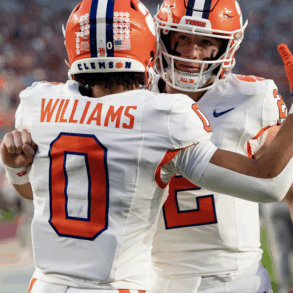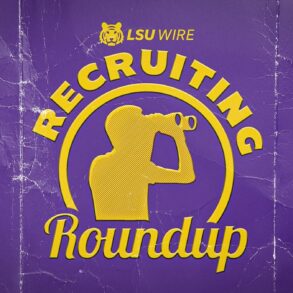AMHERST, Mass. — It’s three hours before the spring football game, and tailgates have already started popping up.
Kirt LaFrance unfolds his camping chair on a strip of grass. Bob Casaceli stirs a pot of chili and plops sliders on the grill. Country music blares across the parking lot.
The Easter weekend crowd is predictably small — 228 fans in the bleachers at kickoff. But the despair from another losing fall subsided months ago, and winter, at last, has melted away. White magnolias are blooming, red buds are poking through branches and the football team has a new head coach.
Advertisement
Hope springs eternal. Even at UMass.
Since moving up from the Division I Football Championship Subdivision (FCS) to the Football Bowl Subdivision (FBS) in 2012, the Minutemen have been, by far, the worst program. Their 26-122 record (.176 winning percentage) in 13 seasons is almost one victory per year below the second-worst team, Kansas. Their scoring differential (minus-2,467 points) is 400 points worse than the Jayhawks, 600 worse than New Mexico State and 800 worse than UConn and UTEP.
“We’re a joke,” said Corey Schneider, a co-founder of the Minutemen’s now-disbanded football NIL entity, The Midnight Ride Collective.
Schneider hears the punchlines nearly every time he introduces himself as a UMass graduate. One of the school’s most prominent sports alumni, ESPN writer Dan Wetzel, has quipped about merging rosters with UConn. A YouTuber who has visited nearly every FBS stadium dubbed UMass’ venue the worst in the country in a video viewed more than 3 million times.
I’ve been to over 100 college football stadiums
I say with full confidence this is the worst one in the country pic.twitter.com/G9EQDcGn2v
— GFed (@GfedGoCrazy) July 5, 2024
Quinton Sales just shakes his head. As one of the captains during UMass’ FCS-to-FBS transition, he knew his team would ache through the program’s inevitable growing pains. But growing pains require growth, not double-digit losses to Buffalo and Northern Illinois like he withstood 12 years ago.
“No reason to be this bad for this long,” Sales said. “No reason.”
The explanation goes beyond the typical problems of losing programs: poor quarterbacking (UMass hasn’t had a passer with 10 touchdowns in a season since 2018), bad coaching hires (first-time flops Charley Molnar and Walt Bell, unsuccessful retreads Mark Whipple and Don Brown, who was fired last November), lackluster recruiting (one class ranked in the top 105 of the 247Sports Composite) and the instability of five coaching changes in 15 years. Deeper woes require deeper roots.
Advertisement
The trouble began, according to interviews conducted by The Athletic with more than a dozen UMass stakeholders, when a sliding FCS program jumped to the sport’s highest division without a plan, in a move its chancellor said might not last. The flagship university of the state with the nation’s highest median household income gave its front porch a bare-bones budget that made a future NFL head coach one of the lowest paid assistants in the nation. The Minutemen started from behind and never caught up.
Most losses by FBS teams since 2012
| Team | Wins | Losses | W% | Avg. margin |
|---|---|---|---|---|
|
26 |
122 |
.176 |
-16.7 |
|
|
38 |
117 |
.245 |
-13.4 |
|
|
44 |
110 |
.286 |
-10.5 |
|
|
46 |
107 |
.301 |
-10.2 |
|
|
46 |
105 |
.305 |
-12.1 |
|
|
51 |
103 |
.331 |
-7.6 |
|
|
44 |
103 |
.299 |
-11.2 |
|
|
56 |
102 |
.354 |
-6.4 |
|
|
54 |
102 |
.346 |
-10.2 |
|
|
50 |
102 |
.329 |
-9.2 |
|
|
63 |
102 |
.382 |
-8.1 |
When UMass prioritized the other revenue sport, men’s basketball, it doomed football to the purgatory of independence and years of laughers against Penn State (63-0) and Pitt (51-7), FIU (44-0) and Toledo (55-10) and even FCS programs Southern Illinois (45-20) and Maine (35-10).
“Frankly,” said booster Marty Jacobson, whose name adorns the football performance center and press box, “a lot of us are tired of losing.”
And they’re starting to do something about it.
The potential for disaster was evident long before the jokes. The proof rests near the back of a nondescript box in the tallest building on campus.
It’s part of a task force report submitted to UMass’ chancellor in 1996 as the school considered moving its up-and-down program to Division I-A, now called FBS:
If a decision is made to implement the move to IA, the move will most likely meet failure without full support of all parts of the University including: academic, student, administrative, and staff.
James Madison supported its move to the FBS in 2022; according to figures submitted to the U.S. Department of Education, the Dukes entered the Sun Belt with the largest athletic budget in the conference. They are 28-9 over three seasons. Georgia Southern supported its jump, too; its students preemptively approved a $75 semester fee to fund a potential bump up and have watched their Eagles become a regular bowl team. Liberty started with the sixth-highest football budget ($22.9 million) in the Group of 5 and has never had a losing FBS season.
UMass didn’t want to listen. The prescient warning was cut from the task force’s final version and is buried on the last page of a minority report, now housed in the W. E. B. Du Bois Library’s archives.
Though the Minutemen did not leap to the FBS then, they probably would have been better off if they had. Their athletic department was still buzzing after John Calipari led the men’s basketball team to that year’s Final Four, and football was about to peak by winning the 1998 FCS national championship and playing for another in 2006.
Advertisement
“If you had the right people in place with the right forethought, I think it would have been a home run,” said ESPN analyst Rene Ingoglia, UMass’ All-American running back in 1994-95. “They went the opposite way.”
When a football-only invitation to the Mid-American Conference came in 2011, the Minutemen weren’t ready. On the field, UMass didn’t move up with the momentum or roster depth of James Madison (a perennial FCS power), Appalachian State (a regular FCS playoff team) or Sam Houston (two years removed from an FCS title). The Minutemen went 23-22 over their final four FCS seasons.
Off the field, UMass had not sufficiently prepared to join the highest division. The necessary support was missing. Schneider, then a recruiting/operations intern, said it felt like the Minutemen were simply in the FCS one day and the MAC the next because he witnessed so little build-up.
“I would say that I think the institution as a whole and the athletics department were surprised by the level of investment and commitment it took to be relevant in the Football Bowl Subdivision,” said athletic director Ryan Bamford, who took over in 2015.
Though the school increased its football expenses by almost $2.2 million from 2010-12, UMass started from behind. In Year 1, its $750,000 assistants salary pool was seventh-lowest nationally and third to last in the MAC (ahead of only Kent State and Bowling Green), according to USA Today’s database. The next year, it was $200,000 behind FBS startup Georgia State. By 2015, the total coaching salary pool was $1.43 million — ahead of only Buffalo in the MAC and almost $1 million behind P.J. Fleck’s Western Michigan staff, according to the Knight-Newhouse database.
“I think the truth and the reality is that there wasn’t a ton of investment and resources at the time when that transition was made,” said former UMass tight end Adam Breneman, now a Front Office Sports podcast host and analyst for CBS Sports and Yahoo. “When you have position coaches making under $100,000 a year, you’re not going to be able to keep anybody in college football if they’re good.”
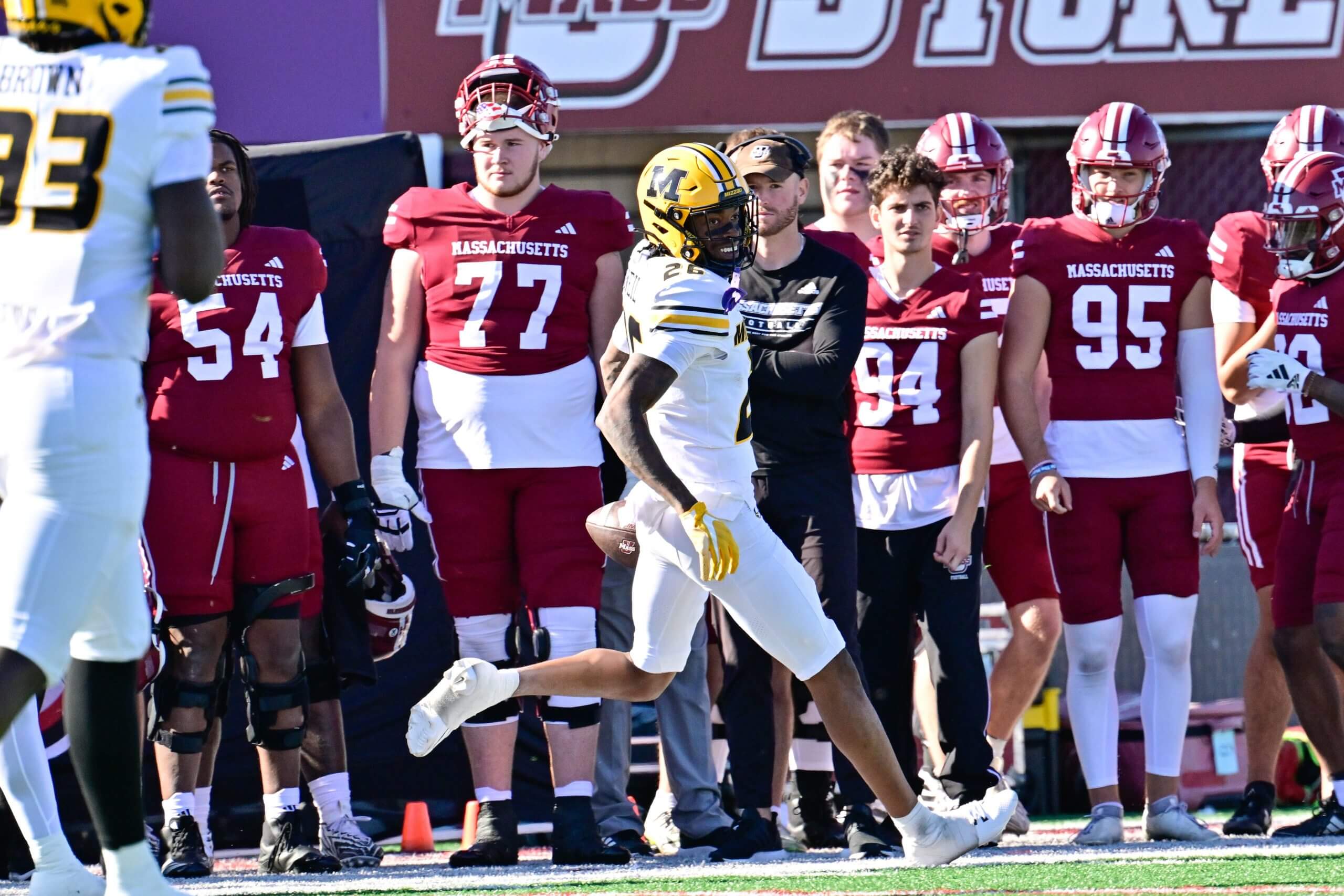
UMass is 0-14 against teams from the SEC since 2012. (Eric Canha / Imagn Images)
UMass’ all-time leading passer, Liam Coen, earned significantly less than that in 2014. His starting salary ($64,500) made him the lowest-paid quarterbacks coach in the FBS, according to USA Today’s database. Coen left his alma mater after two seasons to become an FCS coordinator at Maine. He developed into one of the hottest names in the NFL’s last coaching cycle and is now the first-year head coach of the Jacksonville Jaguars.
Advertisement
Other facets were similarly behind. Media guides list only four new staffers during the 2011-12 transition: a recruiting grad assistant, an assistant strength coach, an academic counselor and administrative assistant. Even with the additions, the Minutemen still had four fewer support staffers (11) than MAC colleague Northern Illinois.
UMass didn’t break ground on a football operations center until two years after the FBS move was announced. Sales and his teammates trained for a higher level of competition in the same weight room with the same strength coach.
“It just felt like a different mission in the same room,” Sales said.
UMass since its FBS jump
| Season | Record | Scoring Off | Scoring Def | Wins |
|---|---|---|---|---|
|
2024 |
2-10 |
110th |
125th |
Wagner, Cent. Conn. St. |
|
2023 |
3-9 |
96th |
133rd |
Merrimack, Army, New Mexico St. |
|
2022 |
1-11 |
131st |
104th |
Stony Brook |
|
2021 |
1-11 |
126th |
130th |
UConn |
|
2020 |
0-4 |
127th |
122nd |
|
|
2019 |
1-11 |
118th |
130th |
Akron |
|
2018 |
4-8 |
35th |
127th |
Liberty, UConn, Charlotte, Duquesne |
|
2017 |
4-8 |
47th |
93rd |
BYU, Maine, App. St., Ga. Southern |
|
2016 |
2-10 |
110th |
108th |
Wagner, FIU |
|
2015 |
3-9 |
108th |
92nd |
Buffalo, EMU, FIU |
|
2014 |
3-9 |
78th |
105th |
Ball St., EMU, Kent St. |
|
2013 |
1-11 |
123rd |
98th |
Miami (OH) |
|
2012 |
1-11 |
124th |
121st |
Akron |
The school’s on-campus home, McGuirk Alumni Stadium, was nearing 50 years old and didn’t have the press box or other infrastructure required to support a high-level program. The Minutemen chose to relocate games two hours southeast to the Patriots’ stadium in Foxborough.
The move was intended to reacquaint the program with Boston-area alumni while playing in one of the finest venues in the country. At the time, then-athletic director John McCutcheon called Gillette Stadium the football team’s home “for the foreseeable future.” Fourteen years later, Bob McGovern calls the decision a “disaster.”
“You ripped the team away from its fan base,” said McGovern, a 2005 UMass graduate who covered the program for the Maroon Musket.
Attendance figures reflected that. UMass’ average crowd (10,901) was fourth-worst in the FBS in 2012. The finale against Central Michigan drew an announced attendance of 6,385, meaning more than 90 percent of the 68,000-seat stadium was empty. UMass stayed in Foxborough the next season and continued playing select games there until 2018.
Football never got full support from academics, either. The faculty senate formed a committee to scrutinize the FBS budget and discuss alternative uses for the new expenses. If the program needed a vote of confidence after a 1-11 inaugural FBS season, then-chancellor Kumble R. Subbaswamy chose not to provide one.
“It’s a very easy matter,” he told The New York Times in 2012, “to one day say we won’t do it anymore.”
Though the school never pulled the plug on football, UMass’ powerbrokers pulled back during a fork-in-the-road moment a year and a half later.
A clause in its deal with the MAC essentially gave the school two options: become a full-time member of the conference or leave. Full membership would stabilize a 2-22 FBS program but push its men’s basketball program away from the Atlantic 10, a strong mid-major league that was poised to earn a record six bids in the upcoming 2014 NCAA Tournament (including UMass).
Advertisement
“At the time,” Jacobson said, “we looked at ourselves as a basketball elite.”
So UMass prioritized basketball, forcing football into independence. Difficulties swelled.
Seven years after the FBS transition, eight of the 10 on-field assistants made less than $90,000. A director of player personnel made less than $30,000 in base pay. A director of football operations earned less than $40,000.
UMass lagged behind in everything from dorms to travel, one former assistant said. The difference between UMass and Conference USA felt bigger than the difference between Conference USA and the SEC.
“It was frustrating to get blamed as a coach when everybody in the building knows it’s a resource issue, not a coaching issue,” said the former assistant, granted anonymity in exchange for his candor. “You’re really resourced like an upper FCS team.”
Lacking conference TV revenue, UMass helped fund the program by loading up on paycheck games against power-conference opponents — 19 of them over eight seasons as an independent (excluding the 2020 season that was shortened by COVID-19). The Minutemen lost them all by a combined score of 842-287. In 2016, UMass played Florida, Boston College and Mississippi State in the first four weeks and traveled to South Carolina in October.
“How do you expect to survive a season doing that?” asked Scott Woodward, a staffer from 2015-18 and backup quarterback on the 2006 FCS finalists.
Independence brought other challenges; there’s a reason Liberty, Army, BYU and New Mexico State have all joined leagues since 2022. Inconsistent schedules made it hard to forge rivalries or build rapports with regular officiating crews. Game-planning was trickier without common opponents to study or previous years to reference. With no real independent peers — Notre Dame is in a class by itself, and UConn’s football budget is 69 percent larger — there are no helpful comparisons. No best practices in staffing or infrastructure, no barometers to measure yourself against.
“It’s no-man’s land,” Bamford said, “and it’s lonely.”
The early-bird tailgaters never got much company outside McGuirk Alumni Stadium before last month’s spring scrimmage. The vibe before kickoff was relaxed enough that a woman could walk her dog behind the goalpost not long before kickoff. A stadium pulse video board graphic tried to enliven an audience of empty bleachers. Students had cleared out for the long holiday weekend, but that didn’t stop the farmers’ market from drawing a comparable crowd at the downtown common.
Advertisement
This isn’t a punchline. It’s the reality of a program that went 18-82 as an independent and, as new head coach Joe Harasymiak said, has left its fans “beat down for so long.”
It’s also a reality the Minutemen are confronting.
“We couldn’t keep doing the same thing and expecting different results,” Bamford said.
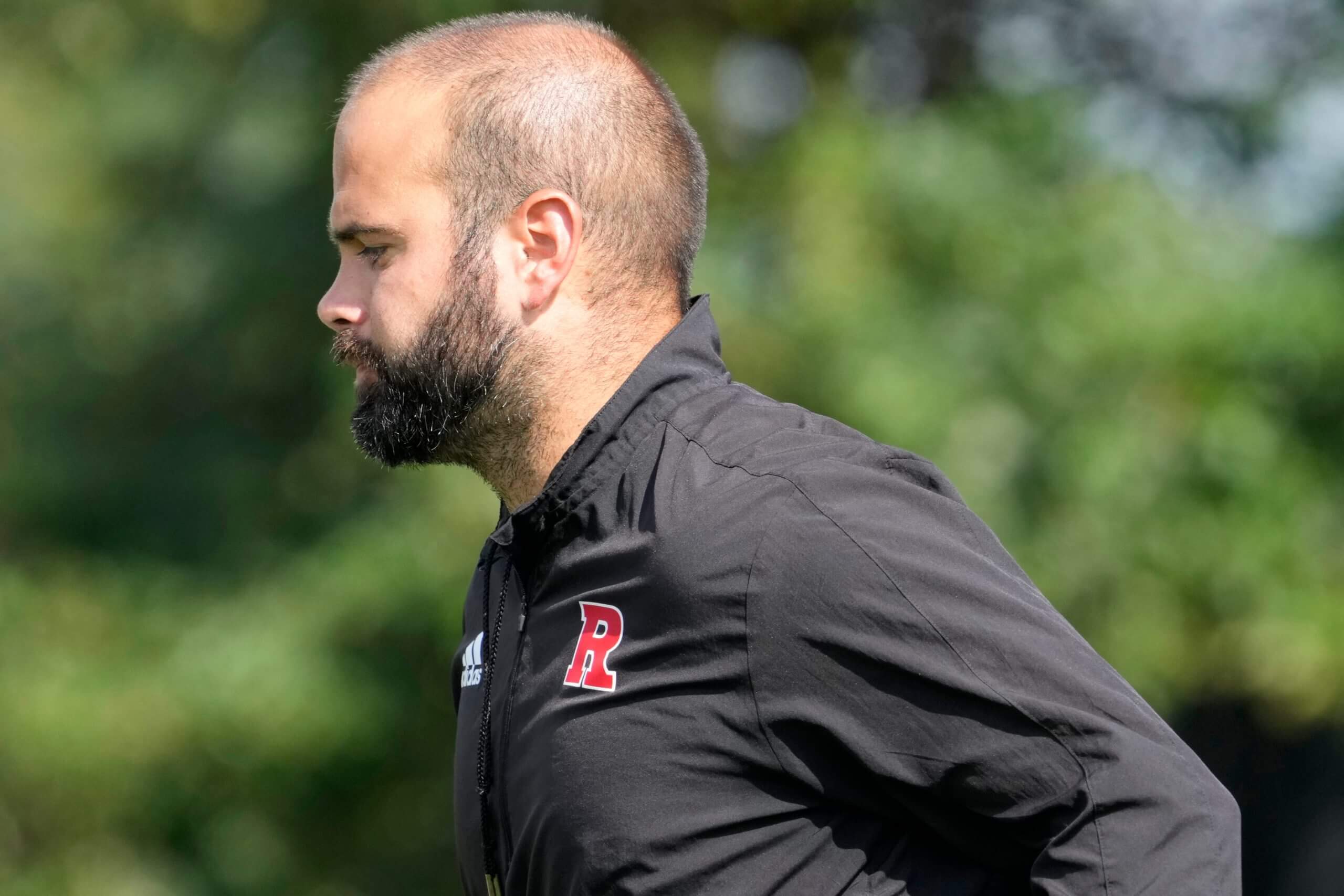
New UMass coach Joe Harasymiak has been an assistant at Minnesota and Rutgers since leading Maine to the FCS semifinals. (Kevin R. Wexler / USA Today Network)
Shutting down the program was never an option, Bamford said, regardless of how many times outsiders asked him about it. Neither was dropping back to FCS. In addition to damaging UMass’ brand, it would have hurt the institution’s bottom line; the school’s contribution to football is $2.5 million less in the FBS than FCS.
Bamford spent years searching for a football-only spot in a conference, but nothing materialized. UMass’ two viable considerations were full-time membership in Conference USA or the MAC. That meant revisiting the basketball-or-football debate at a campus where you’ll still find Marcus Camby jerseys (even at the spring football game).
Though football is the premier program at most schools, the Camby-Calipari basketball heyday remains UMass’ most prominent athletic success (the 2021 men’s hockey national title is up there, too). March Madness still gives mid-major schools a path to national relevance in a way MACtion does not, which is something broadcaster Josh Maurer said the school must consider.
“UMass has been that school in the past, and I don’t think it’s impossible to think that they can be again in the future,” said Maurer, the “Voice of the Minutemen” from 2008-18.
The Minutemen considered it, then rejected it. A decade after prioritizing basketball at football’s expense, they made an about-face.
As bad as the football program has been, the sport’s national popularity still gives it the most upside as a university marketing tool. UMass’ neighbor, UConn, was similarly dreadful (4-32 from 2018-21) but won the Fenway Bowl last year. If the Huskies can play postseason football and make the NCAA tournament in basketball and hockey, why can’t the Minutemen be at least competent in all three? Why can’t UMass become competitive in the fluid MAC, which has had five different champions in the past five seasons?
Advertisement
Besides, focusing on basketball ignores how much the hoops landscape has changed. UMass’ glory days are almost 30 years in the past. The program hasn’t made the March Madness field in 11 years, and power conferences are squeezing out mid-majors. This season’s Atlantic 10 was, like the MAC, a one-bid league.
“We’re kind of leaning into being more of a football school,” said Patrick MacWilliams, the founder and director of The Massachusetts Collective, a hoops-first entity that absorbed football NIL late last year. “I think every school across the country is leaning that way, too.”
Whether UMass succeeds depends on how strongly the program is receiving the full support necessary to avoid more failure.
There are early reasons for optimism. Instead of entering the MAC with one of the smallest budgets, the Minutemen will rejoin with a financial advantage. Harasymiak will be among the MAC’s highest-paid coaches (average salary over five years: about $1.4 million). The overall coaching pool salary, Bamford said, will be the highest in the conference by about half a million dollars. UMass’ NIL budget — $2 million this season, $3 million next — is more than six times what it was in 2024 and expected to be tops in the MAC. The Minutemen launched a new fundraising initiative, the Script U Scholarship Society, to gear up for the revenue-sharing era expected to begin this year. Their 10-year-old football building is in the middle of a $2 million locker room renovation, and Harasymiak has revamped the nutrition program while hiring about 25 of the 30 football staffers.
“Those things don’t happen overnight,” Bamford said, “but that lack of success helped us go make the case (for change).”
Changing the biggest eyesore — a 17,000-seat stadium supporters concede is decades behind the times — won’t happen overnight, either. But the renderings sitting on Bamford’s desk show upgrades are a priority. The Minutemen are considering a short-term fix ($10 million in cosmetic renovations) while the university pursues a nine-figure public-private partnership to overhaul the venue and surrounding area.
“I’ve got to put asses in the stadium first,” Harasymiak said. “You’ve got to get people to come. That’s my job.”
Though none of UMass’ last four coaches won more than three FBS games in a season, Harasymiak has a profile that makes sense. The 38-year-old led another program in the region, Maine, to its first FCS semifinal appearance in 2018, then did more with less as the coordinator of top-20 defenses at Rutgers and Minnesota. He went to school 30 miles south at Springfield College and has recruited the East Coast for years. He’s embracing UMass’ reputation as a top-30 public institution by mining the nearby Ivy League in the transfer portal.
Advertisement
Most importantly, he has help. Harasymiak sensed it during the interview process when the athletic director, trustees and school chancellor who was inaugurated last year stressed how important it was to finally get football right.
“I knew that I wouldn’t be fighting alone,” Harasymiak said.
Even with that backing, the fight won’t be easy. There were more signs on campus for an undergraduate research conference than the spring game. A nonconference schedule set to lighten in future years has trips to Iowa and Missouri this September. Getting New England fans excited about playing directional schools in the Midwest will be a challenge. The stain of a dozen dreadful seasons won’t fade easily.
But look past the gravel road behind the Spartan home of UMass football, and you can envision a path toward respectability. There are buds of hope poking through at the worst program in the country.
“I say this kind of jokingly, and I’ve said this to a lot of people,” MacWilliams said. “We can’t get worse.”
(Top photo: Todd Kirkland / Getty Images)
This post was originally published on this site be sure to check out more of their content.



